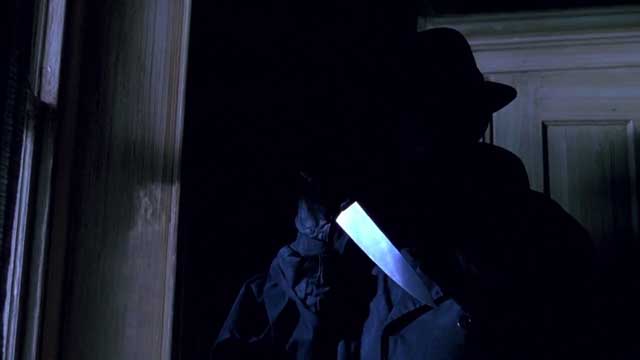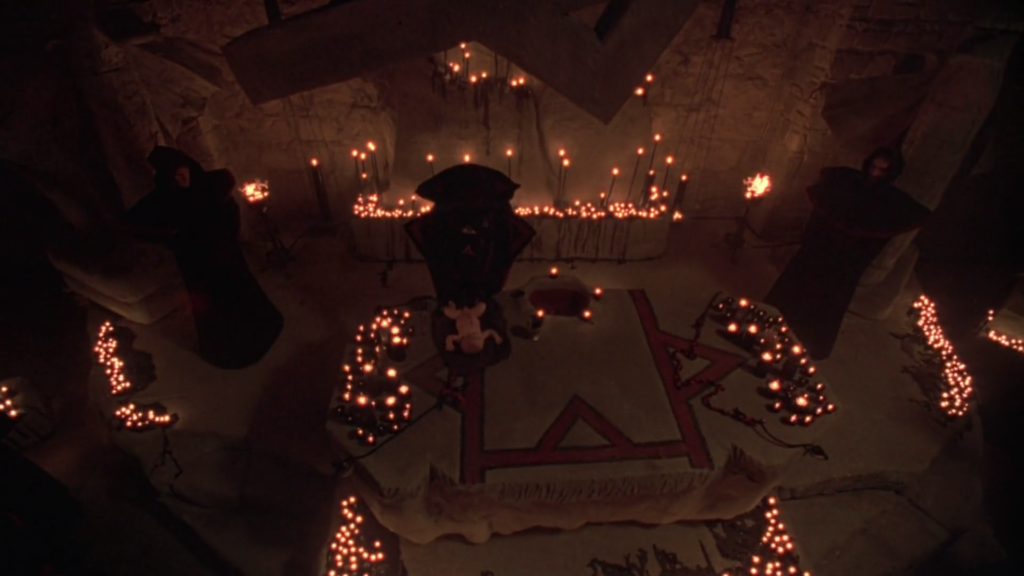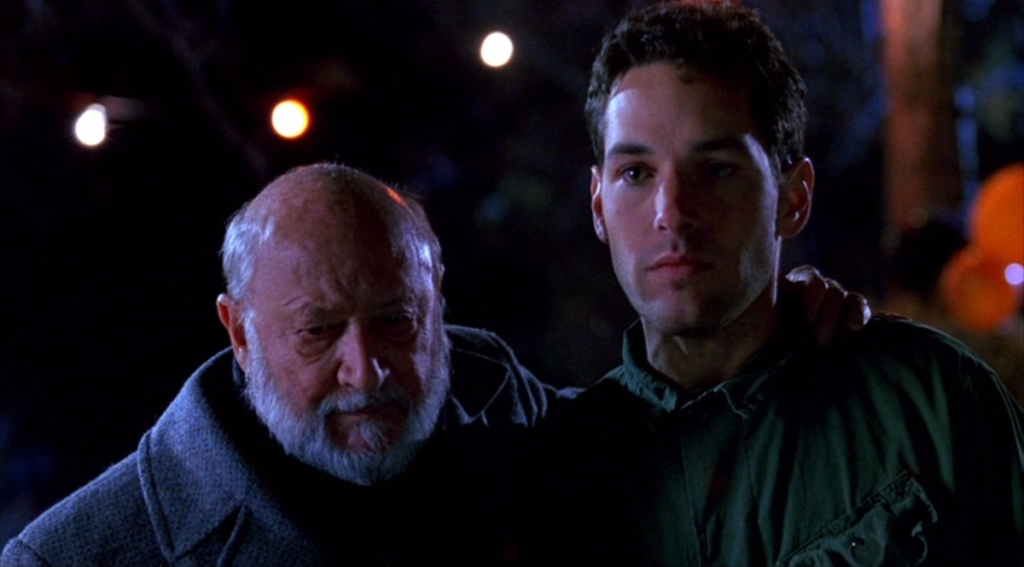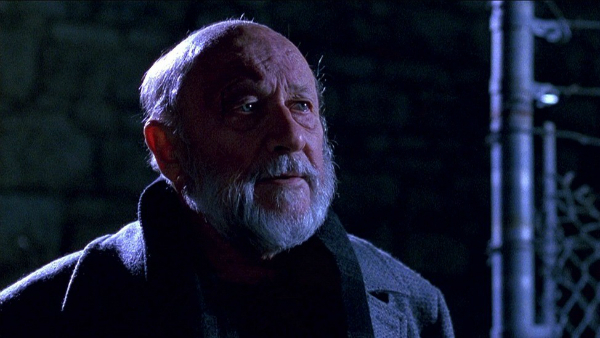How one of the goofier Halloween movies taught me to think beyond Hollywood depictions of Paganism, with a brief tribute to Donald Pleasence.
While Halloween 4 succeeded in breathing fresh life into the Halloween franchise, the series was almost killed off again with Halloween 5 (1989), which was rushed into production as soon as Halloween 4 proved successful. The production didn’t even have a completed script when filming began, and boy does it show. Halloween 5 is a sordid mess, with characters behaving in contemptible ways that make absolutely no sense, and with several aimless plot threads that were clearly only included to build up hype for the next movie. The most obvious of these missteps is the Man in Black, a mysterious asshole who wears cowboy boots and who keeps walking in and out of the movie, showing up at the very end to bust the Shape out of jail and kidnap his niece, Jamie Lloyd. And though Halloween 5 implied that the next installment would be released ASAP, we were not given Halloween: The Curse of Michael Myers (otherwise known affectionately as Halloween 6) until about half a decade later.

When Halloween 6 opens, we learn the Man in Black leads a cult that appears to worship Michael Myers, and which has forced Jamie to bear a child (more on this in just a moment). One of the cultists seems to have a change of heart and helps Jamie escape with her newborn baby; but the Shape pursues them back to the town of Haddonfield, and yet another holiday murder spree begins.

There are actually two versions of Halloween 6—the 1995 Theatrical Cut, and the original Producer’s Cut (which wouldn’t see an official release until the 2010s). Both cuts are radically different from each other. The Producer’s Cut is what was originally put together before Donald Pleasence passed away shortly after filming wrapped in 1995. The director, Joe Chappelle, then re-filmed the entire ending and re-edited the rest of the movie for no apparent reason. We are thus left with two very unique films that tell completely asynchronous stories. Both versions are about Michael Myers stalking his niece, her baby, and a family that has moved into the Myers House (relatives of Laurie Strode, in fact). But the Producer’s Cut explains that Myers is merely a puppet for the Man in Black, who appears to be driven by (fanatical) Pagan beliefs. In the Theatrical Cut, the Man in Black’s motives are revealed to be more pseudoscientific than occult, and it turns out he does not actually have the Shape under his control at all.

Both versions of Halloween 6 feature a cult of so-called “druids” who worship a theoretical demon called “Thorn.” Both versions also posit that Michael Myers is possessed by this demon, thereby explaining his immortality and his drive to kill. The symbol for Thorn is actually the Norse rune Thurisaz (the third letter of the Elder Futhark), and it has nothing to do with the druids or with Celtic polytheism. It represents Mjollnir, the hammer of the thunder God Thor, and it is used to magically harness destructive and chaotic energies for protective ends. It is similar in principle to Khepesh, the starry Iron of Set, and and to the use of gargoyles in Christian church decor; it’s not about glorifying evil, but repelling it. So when certain characters claim that “Thorn” demands one family in Haddonfield be ritually murdered every now and again—and that Michael is simply the current bearer of this curse—I can confirm this is complete bullshit. This stuff is not based on any authentic Paganism; the writer, Daniel Farrands, simply pulled it out of his butt to fill all the gaping plot holes left over from Halloween 5.

While the Producer’s Cut still follows the tried and true slasher formula (“spooky killer stalks protagonists one-by-one”), it also follows the Satanic Panic formula (“community is besieged by murderous, rapey witches”). Here is where we return to the subject of Jamie Lloyd’s baby, who is eventually named Stephen. The parentage of this child is extremely controversial. In the original script, Stephen is the result of Jamie’s rape by the Man in Black, who impregnates her so that yet another member of the Myers family can be offered to Thorn. While the film was being shot, the script was rewritten on an almost daily basis, and for some unholy reason, someone thought it was a good idea to have Stephen be Michael’s kid instead. There is actually a flashback which implies the Thorn Cult tied Jamie to an altar and forced the Shape to rape her. There are so many things wrong with this idea, I’m not even sure where to begin. First of all, the Halloween movies generally aren’t known for using rape as a convenient plot device. The Shape is a brutal killing machine, and murder has always been its sole biological imperative; it’s never shown any kind of sexual interest in its victims whatsoever. And the idea that anyone could “force” the Shape to rape someone—given that this motherfucker can rip people’s skulls apart with its bare hands—is just ridiculous.

Those of us who grew up watching her in Halloween 4 and 5 really look up to Jamie Lloyd’s character; so when Halloween 6 was still in the works, we were all anxious to see how this mighty young warrior would outwit the Shape once again. And we were all promptly heartbroken. It’s bad enough that they didn’t want to pay Danielle Harris the salary she deserved and cast an older woman (J.C. Brandy) in the role instead. (Jamie should have been about 15 or so in 1995; but J.C. Brandy was clearly in her late twenties or early thirties when Halloween 6 was made.) It’s even worse, however, that they decided to write Jamie out of any future sequels by having her be raped and killed. Yes, these are horror movies, it’s understood that upsetting things are going to happen. But this was an awful, thoughtless, and totally mean-spirited thing to do to a beloved, cherished character. The truth is, I’m glad Danielle Harris wasn’t in this one, because I wouldn’t be able to sit through it at all if I had to watch the real Jamie Lloyd suffer such a cruel fate.

In the Theatrical Cut, baby Stephen is strongly hinted to be a product of artificial insemination. Both versions end at Smith’s Grove Sanitarium, which is the Thorn Cult’s base of operations; and both versions reveal the Man in Black to be Dr. Terence Wynn (played by Mitch Ryan, otherwise known as Will Riker’s dad), who is the head of the hospital. But here is where the similarities end. The Producer’s Cut concludes with Dr. Loomis and company disrupting a sacrificial ceremony and binding the Shape with “the power of the runes.” The Theatrical Cut climaxes with our heroes learning that the Thorn Cult is not really a cult at all, but a bunch of mad scientists conducting some ghoulish lab experiment. The sanitarium is filled with human fetuses in test tubes, and Dr. Wynn mentions something about Stephen being “a very special baby” who represents “the dawn of a new age.” We also learn the Shape has been murdering pregnant women in the hospital who seem to be related to the test tube babies somehow. The Thorn scientists don’t seem to be aware of Michael’s activities at present, perhaps thinking they have safely locked him away. That’s when the Shape busts in on their operation and butchers every scientist in sight. It then comes down to Paul Rudd bludgeoning Myers with a big lead pipe in a room full of fetuses (and trust me, it’s every bit as spectacular as it sounds!).

None of these events are ever explained in any coherent way, and one fan’s interpretation of events is as good as another’s. But for what it’s worth, here’s what I think the Halloween 6 Theatrical Cut is trying to say with all this craziness. Dr. Wynn and his cronies never believed in Thorn at all; they simply pretended to worship the force possessing Michael so he would allow them to get close to him. They don’t really believe in the Boogeyman, but they do acknowledge Michael’s superhuman strength. Their true goal is to clone the Shape’s DNA; perhaps they work for the military, or maybe they just want an army of Shapes they can control. They artificially inseminated all of their female “patients,” including Jamie, with little Myers clones, and Stephen has proven to be some kind of breakthrough. More than anything, they want Stephen back so they can continue their experiments on him; so they release Michael to track him down, with plans to recapture the Shape before it can actually murder its prey. After succeeding at this, Dr. Wynn dispenses with all pretense at being a “druid,” thinking he has fooled the Shape. But Michael Myers has actually been in control of the entire situation all along, keeping the “Thorn Cult” close to himself for his own purposes. And that’s when these other villains who think they’re oh so bad find out the Boogeyman is VERY fucking real, indeed!

Given this interpretation of events, I much prefer the Halloween 6 Theatrical Cut to the Producer’s Cut. The former is essentially an X-Files episode that just happens to feature Michael Myers, with tons of bizarre shit happening and none of it being explained (saving material for future installments). While it is still a ridiculous film with many flaws, this leaves a much better taste in my mouth than the alternative. The Producer’s Cut is more like a gothic Hammer film, which I would normally find appealing, save for this: it reduces the Shape to being little more than Kharis the Mummy, with Dr. Wynn as his Mehemet Bey. I also really resent the addition of all that Satanic Panic baloney, which is just unnecessary. The idea of people being raped for witchcraft might be essential to a story like Rosemary’s Baby, but it has never been a part of John Carpenter’s Halloween. With all due respect to Ira Levin, I just do not want to see any of that shit when I put on a Halloween movie. The idea of genetically engineering a race of Michael Myers clones is equally crazy when you compare it to the original 1978 film; but at least it’s my kind of crazy, dammit!

There are certain things about the Producer’s Cut that I happen to prefer, however. For one thing, there’s a whole lot more Donald Pleasence in that version, which is always a good thing (especially since this was his final appearance before he died). For whatever blasphemous reason, most of his scenes are either heavily trimmed or completely removed from the Theatrical Cut, and that’s just insulting. My number one reason for seeing Halloween 6 in the first place was to see how Dr. Loomis is doing, and to see what he does to stop the Shape this time. Removing most of his presence from the film leaves it feeling very hollow, like part of the movie’s soul has been lost. It helps that Dr. Loomis passes the torch to Tommy Doyle (played by Paul Rudd), who witnessed Michael’s first killing spree as one of the child characters in 1978. But the very last scene with Donald Pleasence in the Theatrical Cut (“I have a little business to attend to here…”) never fails to make me tear up a little.
Halloween 6 might be goofier than shit (no matter which of the two versions you prefer to watch), but seeing it was a major step in my coming to Paganism as a teenager. Donald Pleasence is also my all-time favorite actor, and it was very sad for me when his passing was first announced back in February 1995. I have always thought the Thurisaz rune would be much better suited to representing Dr. Loomis as a protector against the Shape, rather than the Shape itself; so I decided to include a song on my new 2020 album, Summer’s End, that honors the concept of Thurisaz, and which is also dedicated to the memory of Donald Pleasence. I pray you will enjoy this offering, good sir!

TO BE CONTINUED…
